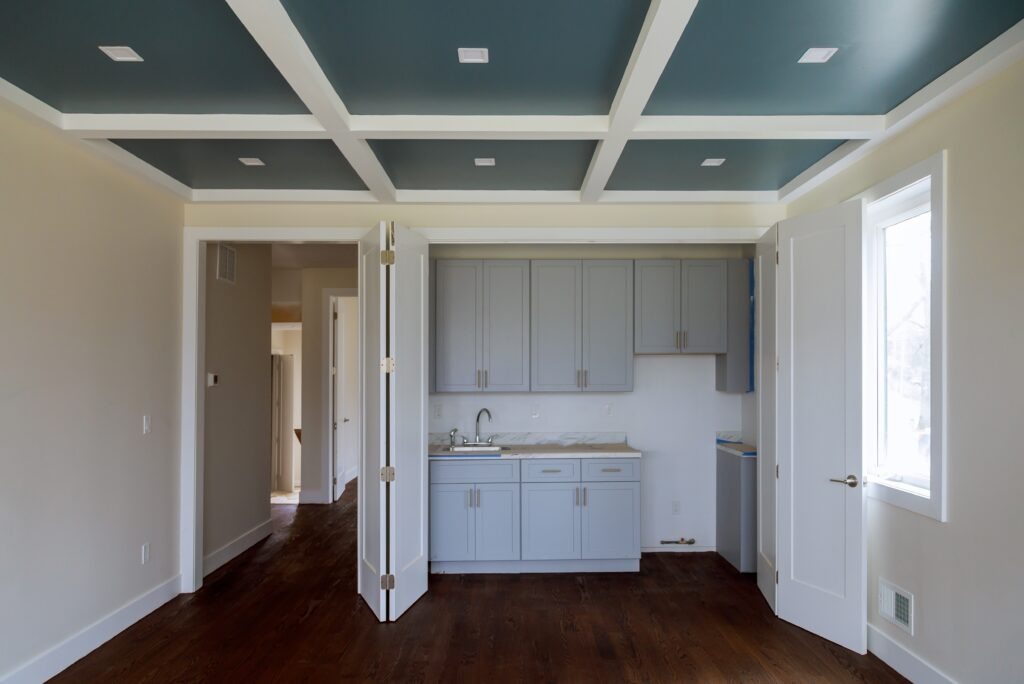At 1 Degree Construction, we specialize in home additions and ADU construction, helping homeowners expand their living spaces with functional, stylish, and high-value upgrades. Whether you need an extra bedroom, home office, in-law suite, or a full accessory dwelling unit (ADU), our expert team ensures that every aspect of your project is handled with precision and attention to detail.
Expanding your home can improve functionality, increase property value, and provide additional income potential. Here’s why homeowners choose to build additions and ADUs:
Add extra bedrooms, a home office, or entertainment areas.
A well-designed addition or ADU can significantly boost resale potential.
An ADU can significantly improve your return on investment opportunities. ADUs can serve as long-term or short-term rental units for additional revenue.
Create a comfortable space for aging parents or adult children.
Customize your home for growing needs without relocating.
Explore our accolades and customer testimonials!
Trustindex verifies that the original source of the review is Google. I cannot say enough great things about this company. We decided to go with them for our kitchen remodel after getting multiple other bids. They were not the cheapest, but also not the most expensive. However, when I contacted them for an estimate and David came out, I quickly became very comfortable and happy with what he had to say/offer/ and explain what was possible. From the original estimate to the final completion of work David was always happy to communicate and explain what they were doing. They were always on time, clear on communication and all of them professional and with a smile. They all took great care in our home. We are extremely happy with the results of our beautiful kitchen and would not hesitate to recommend 1 Degree Construction for any kitchen remodeling project you may have in mind.Trustindex verifies that the original source of the review is Google. We were looking for a contractor for a room addition, not a small project and a big responsibility so we were very careful and too our time to find a reliable company. Finally we found Thai and 1 Degree Construction and from first day we knew we hired great contractor. Thai and his team were great to work with, on time, quick, efficient and on budget. the results are as Thai promised, the final product is top notch. If you need a reliable contractor, we highly recommend 1 Degree Construction!Trustindex verifies that the original source of the review is Google. 1 Degree Construction, led by project manager Thai, brought a fresh and innovative approach to our kitchen remodel. Thai's creativity in design solutions transformed our space into a modern and functional kitchen. The team's attention to detail, combined with their ability to think outside the box, resulted in a truly unique and beautiful outcome. We appreciate the dedication to quality and originality that 1 Degree Construction brought to our project.Trustindex verifies that the original source of the review is Google. Working with 1 Degree Construction on my kitchen remodel was a pleasure. Thai, the project manager, was incredibly helpful in guiding me through the process. The team's efficiency was evident in the quick progress made, and their professionalism was unwavering. I appreciated their honest communication and transparency throughout. The end result is a stunning kitchen that reflects their dedication to quality work. I highly recommend 1 Degree Construction for their helpful and efficient services!!Trustindex verifies that the original source of the review is Google. I had the pleasure of working with 1 Degree Construction for a kitchen remodel, and I couldn't be more delighted with the results. From start to finish, the project was handled with professionalism, precision, and a level of expertise that surpassed my expectations. At the helm of this transformative project was David, the project manager from 1 Degree Construction. His attention to detail and commitment to delivering a top-notch kitchen were evident from our very first meeting. David's wealth of knowledge in construction and design made the entire process seamless and enjoyable. One standout quality of 1 Degree Construction was their commitment to communication. David kept me informed at every stage of the project, ensuring that I was aware of progress, timelines, and any potential adjustments. This transparent approach significantly reduced stress and allowed me to feel confident that my vision for the kitchen was being realized. The craftsmanship exhibited by 1 Degree Construction's team was truly exceptional. From the demolition phase to the installation of custom cabinetry and the final touches, every aspect of the remodel was executed with precision. The attention to detail was remarkable, and it's clear that the team takes great pride in their work. Another noteworthy aspect of my experience with 1 Degree Construction was their adherence to the agreed-upon timeline. Deadlines were met without compromising the quality of work, showcasing the company's commitment to efficiency and client satisfaction. Throughout the project, David demonstrated not only technical expertise but also a genuine passion for creating spaces that enhance the lives of those who inhabit them. His collaborative approach, receptiveness to feedback, and proactive problem-solving skills were instrumental in turning my kitchen dream into a reality. My experience with 1 Degree Construction, led by project manager David, was nothing short of exceptional. If you're considering a construction project, particularly a kitchen remodel, I wholeheartedly recommend 1 Degree Construction for their professionalism, craftsmanship, and dedication to client satisfaction. Thank you, David and the entire team, for transforming my kitchen into a space that exceeds my wildest expectations.Trustindex verifies that the original source of the review is Google. I recently hired 1 Degree Construction for a bathroom remodel, and I am beyond pleased with the outcome. Thai, the project manager, was instrumental in making the entire process smooth and efficient. His expertise and attention to detail were evident throughout the project. The team's workmanship was top-notch, and they completed the remodel within the agreed-upon timeframe. Thai's communication skills and commitment to customer satisfaction set 1 Degree Construction apart. I am thrilled with my newly renovated bathroom and highly recommend this company for anyone looking for excellence in construction and remodeling.Trustindex verifies that the original source of the review is Google. Working with Thai from 1 Degree Construction was a great experience from start to finish. Thai's expertise and creative approach to our bathroom remodel exceeded our expectations. The communication throughout the project was excellent, and the team ensured that everything was completed in a timely manner. The attention to detail and dedication to customer satisfaction were truly commendable. If you're considering a bathroom remodel, I can't recommend Thai and 1 Degree Construction enough. They turned our vision into reality with professionalism and precision.Trustindex verifies that the original source of the review is Google. The other half of the American dream of home ownership is knowing who to call when your 80+ year old house needs repair. In our case, it's 1Degree Construction. PROJECTS 1Degree Construction worked on several consecutive projects for us. We started small. When we saw the quality of their work, we had them do more involved work, including doing mold remediation and fully repairing a termite ridden wall that had been waterlogged. Among other things, this involved redoing the yard drainage while paving part of the yard in a manner that would blend in with the look of house. PLANNING With each project, Omri, the production manager, consulted with us on what we wanted and the accommodations that had to be made to allow us to stay in the house while the work was ongoing. This was important as it related to our health and life circumstances. He was extremely knowledgeable and helpful. His input helped fine tune our planning for the more involved work that had to be done. BUDGET Pricing was very fair and reasonable, and the payment terms very clear. Everything was done on time, or sooner, and on budget. WORK QUALITY 1Degree’s workmanship was first rate and thorough. Their team always showed up on time. They didn’t consider the job done until we were happy with every detail and were at all times respectful of our concerns, property and time. BOTTOM LINE We were so impressed with 1Degree Construction that we have already recommended them to friends. They took a typically stressful experience and made it as painless and affordable as possible. We will not hesitate to use them again.Trustindex verifies that the original source of the review is Google. I collaborated with Thai on my second-floor addition project. Initially, my plan was to demolish the entire house and rebuild it from scratch. However, due to budget constraints, I was unable to proceed with that approach. Fortunately, 1 Degree proposed a brilliant alternative by extending the second floor and remodeling the rest of the house. I couldn't be happier with this solution, especially considering the budget I had available.


At 1 Degree Construction, we offer a full range of addition and ADU construction services to meet your unique needs and budget.
Whether you need extra space for family or hobbies, we provide:

ADUs provide independent living spaces while remaining part of your property. We build:

Accommodate extended family with additional living space, like an ADU.

Maximize vertical space with:

Turn your garage into a functional living space with:

Complete your addition with high-end details, including:

We begin with an in-depth consultation, discussing your vision, layout preferences, and budget. Our team then creates a plan to maximize the existing space in your home. Customized expansion plan tailored to your home’s needs.
We guide you in selecting the best flooring, cabinetry, fixtures, and finishes to complement your home’s design.
We handle all necessary permits and inspections, ensuring compliance with local building codes and regulations.
Our team carefully prepares the construction site, handling demolition and structural modifications with minimal disruption.
Our skilled craftsmen execute each phase with precision and efficiency, ensuring your addition is built to the highest standards.
Before completion, we conduct a thorough inspection to confirm every detail meets our quality expectations.
Ready to get started on your next design and build project? Contact 1 Degree Construction, with decades of experience, we’re homeowners first choice for remodeling projects in Los Angeles.
Or simply fill out our online contact form for a free consultation. Let’s build something extraordinary together!
The cost of a home addition or ADU depends on size, materials, and project complexity. Factors like foundation work, structural reinforcements, and high-end finishes can all impact pricing. Here’s a general cost breakdown:
Working with an experienced contractor ensures that costs are allocated efficiently while maximizing your home’s value.
Several factors contribute to the overall cost of building an addition or ADU, but some of the most expensive elements include the existing structure and permitting fees.
Carefully planning your budget and prioritizing must-have features can help control costs while achieving a high-quality build.
Accessory Dwelling Units (ADUs) provide multiple benefits, including:
A well-designed and properly permitted ADU can provide additional living space for your family. Increase property value by 20-30%, depending on location and size. Additionally, ADUs provide rental income potential, making them an attractive option for homeowners looking to generate passive income. Many buyers are also drawn to homes with ADUs for multigenerational living, guest space, or home offices, further increasing resale desirability.
Please take a look at our portfolio page for inspiration!
The timeline for a home addition or ADU depends on Project scope, permitting, and construction complexity are crucial when considering adding an ADU.. Here’s a general timeframe:
Delays may occur due to permit processing, weather conditions, or material availability, so working with a contractor who ensures efficient project management is key.
Yes! ADUs are one of the best long-term investments for homeowners. They provide:
With growing demand for affordable housing and flexible living spaces, ADUs are a smart investment for financial and lifestyle benefits.
ADU requirements vary based on location, but general guidelines include:
Adding an ADU or expanding your home can increase your property taxes, but only on the new square footage added. The original home’s tax base remains the same, while the additional construction is assessed at its market value. Some areas offer tax incentives for ADUs used as rental properties.
Financing a home addition or ADU can be done in several ways, including:
Choosing the right financing option depends on interest rates, repayment terms, and overall project budget. Consulting a financial expert can help determine the best solution.
Yes, obtaining permits and inspections is required for any major structural changes, including ADUs and home additions. Local building codes regulate:
At 1 Degree Construction, we handle the entire permitting and approval process to ensure your project runs smoothly and legally.
Yes! ADUs can legally be rented out as long as they meet local zoning laws, safety requirements, and rental regulations. Many homeowners use ADUs for:
Some municipalities have restrictions on short-term rentals (Airbnb/VRBO), so checking local guidelines is essential before renting out an ADU.
The choice between a detached vs. attached ADU depends on your budget, available space, and intended use.
Both options add value to your home, but detached ADUs typically provide higher rental income and independent living spaces.
Building a sustainable and energy-efficient home addition reduces utility costs and increases property value. Key features include:
Integrating these elements into your home addition ensures you create more living space. Long-term savings while contributing to a greener lifestyle.
Ready to increase your living space with a custom home addition or ADU? Contact 1 Degree Construction today at to schedule a free consultation. Our expert team is ready to bring your vision to life with high-quality craftsmanship and unmatched service!